A Few Materials We Have Tumbled
The methods described in the articles linked to below are specific to the size, shape, hardness and tenacity of the rough that we were tumbling. Those methods may work poorly for you if your rough has a different size, a different shape, or has other properties different from what we were tumbling. You may produce different results if you use a different tumbler, different grit, or different polish. You should consider our information to be "a report of what happened with our material and methods" and not "instructions for any similar material".
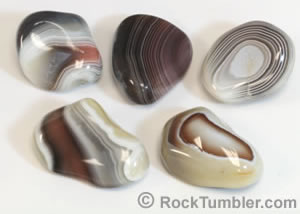
Gray Banded Agate Nodules
A retail page with tumbling instructions. Agate nodules are a favorite tumbling rough among our customers. These agate nodules were eroded from an igneous rock, then transported by streams and wave action. They can be tumbled to a superb polish, but to do that you must tumble them in coarse grit in a rotary tumbler for a few weeks - to remove the surface bruises they accumulated during stream and wave transport.
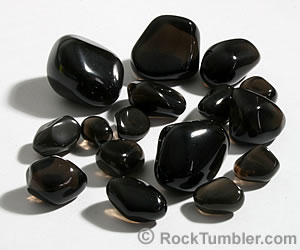
Apache Tears & Obsidian (U.S.A)
An article page that provides tips on tumbling these two natural glasses. In our opinion, a person who can successfully tumble these materials into glossy black gems of high luster - with no chips, scratches or bruises - is a master of the rock tumbling hobby. They are easily scratched, easily bruised, and easily chipped during tumbling. To prevent these injuries, they must be tumbled gently in plenty of media. A vibratory tumbler is the best choice for polishing glasses of all types.
Apache Tears (U.S.A.): A retail page with tumbling recipes. If you want to prove that you have mastered the rock tumbling hobby, this is the material you should attempt. It's not that difficult if you have a good vibratory tumbler and use enough ceramic media to tumble these pieces of natural glass gently.

Basalt Cobbles (Mexico via Home Depot)
These are black stream- and beach-rounded stones that are often used as ground cover in landscaping. We have purchased them in the lawn and garden center at both Home Depot and Walmart. You can sometimes purchase them online with home delivery. If you purchase a 20-pound bag, many of the rocks will be unsuitable for producing a great tumbled stone, but we have always found enough really nice ones to make the purchase worthwhile. Some people tumble these into beautiful, glossy black massage stones. We have seen them in gift shops, priced at $10 each - that is less than what we paid for a 20-pound bag.
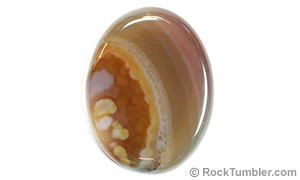
Cabochons
We used to cut a lot of cabochons. We would cut them by hand and then, instead of polishing them by hand on a felt-covered flat lap, we would polish them in large quantities in a Lot-o-Tumbler.
After rough cutting and sanding with medium grit on a lapidary machine, we would load them in the tumbler and run them for two days in fine grit. Then, two days in TXP polish. The best parts... the fine grit step would round the bottom edges of the cab much more nicely than we could do that job by hand. And the TXP polish would produce a super-bright luster on agate cabs. (Do not run them any longer than necessary, or the tumbler might overcut soft spots and undercut hard areas.) The tumbler saved an entire week of polishing by hand on a felt-covered wheel.
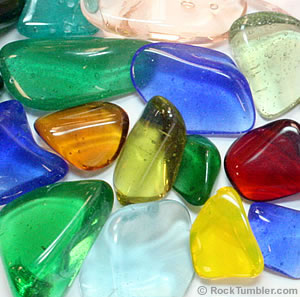
Colored Glass (landscape, bottle, and cullet)
Glass is not difficult to polish in a rock tumbler. But, a challenge is dealing with the gas that is produced. If your tumbler has an air-tight lid, the glass can push or pop it off with messy results. See our article: Do Your Rocks Have Gas? before you start tumbling glass.
Bottle glass is less than ideal for polishing, unless your bottles have very thick walls. The curvature of the pieces usually makes pieces of bottle glass thin and fragile. Our favorite glass to tumble is landscape glass. Finally, if you plan to tumble common glass, then offer it for sale as "sea glass", you are flirting with legal action from one or a group of your customers.
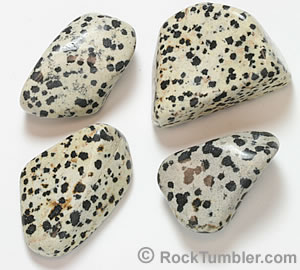
Dalmatian Stone (Chihuahua, Mexico)
A retail page with tumbling recipe. Many people call this material "Dalmatian Jasper". The "Dalmatian" part is correct because it looks like the white dog with black spots. However, the "jasper" part is incorrect because this material is an igneous rock composed mainly of feldspar and a variety of hornblende. These minerals have a Mohs hardness of about 5 or 6. Because of this hardness, we enjoy tumbling this material because it shapes quickly and polishes nicely. It is one of our most recommended tumbling roughs for people who have tumbled agates and jaspers and who now want to try a material that is a little softer.
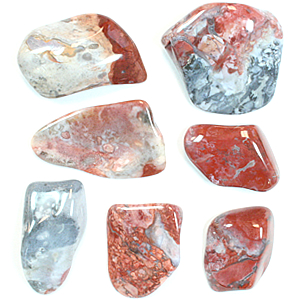
Flint (Flint Ridge, Ohio)
We have tumbled this material from a few sources on Flint Ridge, and each time we have been impressed with its toughness and resistance to rounding in the tumbler. This is one of the few materials that we tumble in coarse grit for a lot of extra time. Sometimes, when we have pieces of two or three inches in size, we have tumbled it for over a month in coarse. The material can be so colorful and takes such a nice polish that it makes the wait and the electricity worthwhile.
Native Americans traveled hundreds of miles to mine this material and traded it across the eastern United States. They valued the material because of its durability in making their tools and weapons.
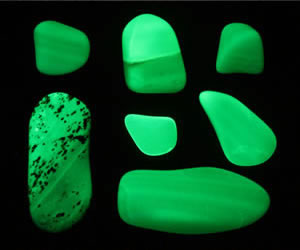
Fluorescent Opal (Virgin Valley, Nevada)
We purchased a few pounds of common opal from the Royal Peacock Mine, located in Virgin Valley, Nevada. One of the varieties we purchased was a "fluorescent opal" with a spectacular fluorescent green glow under short-wave ultraviolet light. Any kind of opal is tricky to tumble. This opal was no exception because some of it was crazed and all of it was very brittle - but we got some nice tumbled stones. FYI: The Royal Peacock Mine is listed on our Fee Mining and Digging page. You can go there, pay a fee, look for opal and keep what you find. If you want to learn more about rock and mineral fluorescence, you can see an article that we prepared for Geology.com.
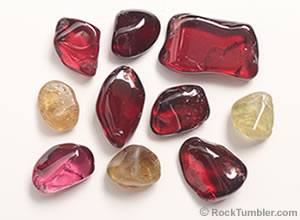
Garnet
Here is what you should realize before you tumble garnet: "The key is not in the procedure, but in acquiring a rough that will perform well."
Garnet is usually a dirty gem that has so many inclusions that it is practically opaque. When you attempt to polish it, the surface will be pockmarked by surface-reaching inclusions that are soft and undercut. If you purchase "garnet tumbling rough", you will tumble it for a month and be disappointed at least 90% of the time. The only way to produce bright, gemmy tumbled stones is to find rough that already looks bright and gemmy. That is very hard to find - especially at a price that most people are willing to pay.
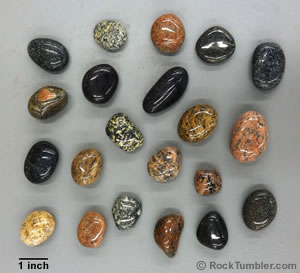
Igneous and Metamorphic Pebbles (Ohio River)
We have often tumbled stream-rounded pieces of granite, gneiss and other igneous and metamorphic rocks that we hand-select from commercial landscape gravels. These gravels are dredged or mined from Ohio River sediments along the Ohio - West Virginia border, then sold by the ton to homeowners and landscape contractors within economical barge and truck transport from the production site. They make beautiful tumbled stones. Pebbles and cobbles between one and four inches in maximum dimension have been sold in our part of southwestern Pennsylvania for decades.
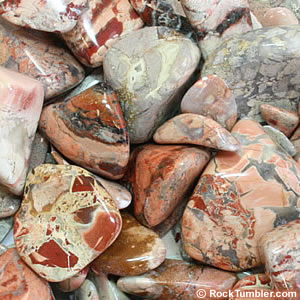
Jasper, Brecciated (Madagascar)
A retail page for a beautiful pink, gray, red, and white jasper from Madagascar. This is one of our favorite tumbling roughs. We like it because this jasper shapes quickly, polishes to a very bright luster, and has a beautiful color with interesting patterns. This is one of our "EASY" roughs, intended for use by beginners in small tumblers such as the Thumler's A-R1 or A-R2. No media is needed; the smaller pieces in the package will serve as your media - and some of them will produce beautiful tiny stones. We have tumbled this rough many times and have been pleased with it every time.
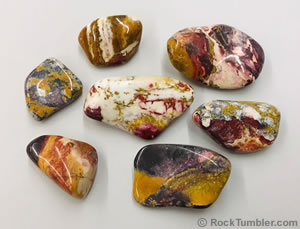
Jasper, Indian Blanket (Utah)
This beautiful jasper was discovered in a quarry in Utah that was being mined for landscape rock. The miner discovered that a small portion of the deposit was a jasper, a few pounds of which could be sold for more than a ton of landscape rock. The early sellers named it for its colorful markings, which reminded them of Native American fabrics. You will be lucky to find tumbling rough of this material today, but cabochons and slabs are occasionally seen on marketplace websites.
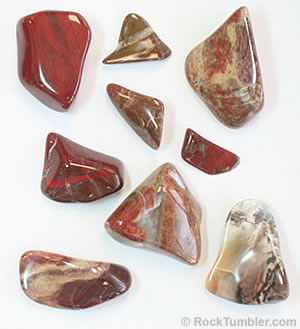
Jasper, Polychrome (Madagascar)
The name "polychrome" means "many colors". This jasper is mostly reds and pinks, mixed with brown, orange, white, gray, and a few tinges of other colors. It takes a great polish and rounds well in a rotary tumbler. This polychrome jasper was mined in Madagascar. Similar material from other locations is also called "polychrome". This is a perfect material for beginners because the small pieces round quickly and no media is needed.
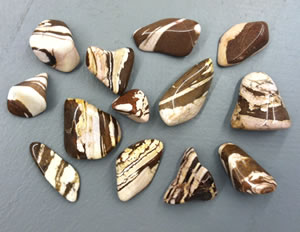
Jasper, Zebra (Brazil)
We tumbled this material several times many years ago. It was our first experience tumbling an exceptionally durable rough that required a month in coarse grit to achieve nicely rounded stones. Some people argue that this should not be called "zebra" because it has brown and white stripes, but there are zebras that look exactly like this material. It was also one of the first materials that we tumbled in rotary to start and then did all remaining steps in vibratory to save time, grit, and electricity. Now we tumble almost everything that way.
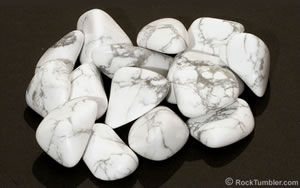
Magnesite, Silicified (Zimbabwe)
A retail page offering unusually durable magnesite. Magnesite normally has a Mohs hardness of between 3.5 and 4.5, but this magnesite has been silicified and exhibits a Mohs hardness of 5+. Being fine-grained and silicified enables this magnesite to be tumbled without fear of cleavage. It shapes quickly and produces a beautiful soft glow when polished. There are two ways to know that this is magnesite and not howlite, with which it is commonly confused. Testing with HCl will produce produce a faint effervescence, or, testing its spot refractive index with a refractometer will produce birefringence blink.
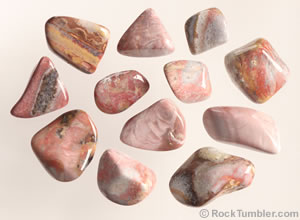
Mozarkite (Missouri, U.S.A.)
Mozarkite is a colorful variety of chert (chalcedony) that is found at numerous locations in Missouri. Top-quality pieces of mozarkite will produce beautiful tumbled stones in a variety of colors (usually swirls, bands, and patches of pink, red, purple, brown, orange, and yellow on a gray to white to brown background). The Missouri General Assembly adopted mozarkite as the "official state rock of Missouri" in 1967. Mozarkite is a very hard and tough rock. If you tumble one-inch to two-inch pieces of broken rough, it might take a month in coarse grit to produce nicely rounded stones - but the wait can be worth it.
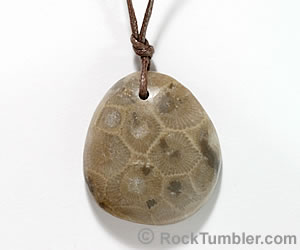
Petoskey Stones (Michigan)
Lots of people want to polish their Petoskey Stones in a rock tumbler. We sell rock tumblers and know a lot about them. But, if we had some nice Petoskey Stones we would grind them to shape and polish them to a bright luster using a lapidary machine. If you don't have a lapidary machine, consider polishing them by hand using automotive sandpaper and a scrap of denim fabric.
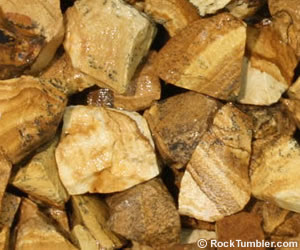
Picture Stone (Namibia)
A retail page offering a beautiful white, cream, tan, and brown "picture stone" that has markings that remind you of a desert landscape. These scenes are fitting because this material is mined in the deserts of Namibia (a country in western Africa). This material shapes quickly in a tumbler and polishes to a wonderful semi-gloss finish. If you like deserts or caramel colors, then you should enjoy this rough for producing tumbled stones or cutting scenic cabochons.
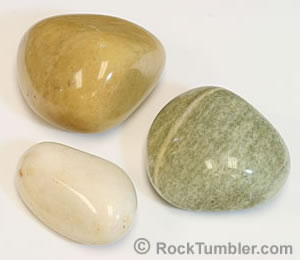
Quartzite Cobbles (Unknown Locality)
We purchased a 40-pound bag of quartzite cobbles (about 2-1/2 to 3 inches across) at the lawn and garden center of our local Home Depot (they called them "river rocks"). Many of them were not suitable for tumbling, but we found enough to produce about a dozen really nice tumbled stones. We tumbled them first in a Model B rotary tumbler and then, a few at a time, we ran them through medium, fine, and polish in a Thumler's UV-10 vibratory tumbler. One of our favorite tumbled stones of all time is the green quartzite cobble with a healed fracture filled with white quartz (shown in the photo at right). It is now one of the prize possessions of our office! Now, every time I go into Home Depot, I am looking for another bag of these rocks.
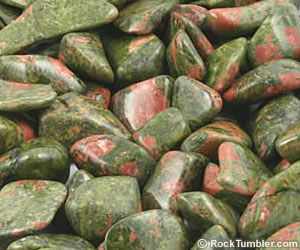
Unakite (South Africa)
A retail page for unakite, a relative of granite, that is composed mainly of pistachio-green epidote and pretty pink orthoclase feldspar. Some people can't believe that there is a tumbling rough with this color combination. Because most of the material in this rough has a Mohs hardness of 6, it shapes quickly in a rotary tumbler. Unakite is named after the Unaka Mountains in western North Carolina and eastern Tennessee (where it is mined as a construction aggregate and landscape stone). However, unakite is found in many other parts of the world, and the material offered for sale on this website was mined in South Africa.
RockTumbler.com Authors
 |
Hobart M. King has decades of rock tumbling experience and writes most of the articles on RockTumbler.com. He has a PhD in geology and is a GIA graduate gemologist. He also writes the articles about rocks, minerals and gems on Geology.com. |

